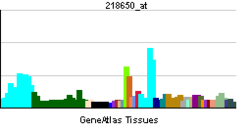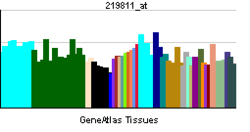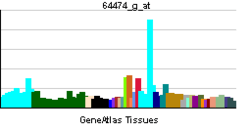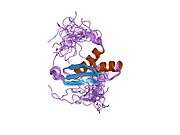DGCR8
| View/Edit Human | View/Edit Mouse |
The DGCR8 microprocessor complex subunit (DiGeorge syndrome chromosomal [or critical] region 8) is a protein that in humans is encoded by the DGCR8 gene.[3] In other animals, particularly the common model organisms Drosophila melanogaster and Caenorhabditis elegans, the protein is known as Pasha (partner of Drosha).[4] It is a required component of the RNA interference pathway.
Function
DGCR8 is localized to the cell nucleus and is required for microRNA (miRNA) processing. It binds to Drosha, an RNase III enzyme, to form the Microprocessor complex that cleaves a primary transcript known as pri-miRNA to a characteristic stem-loop structure known as a pre-miRNA, which is then further processed to miRNA fragments by the enzyme Dicer. DGCR8 contains an RNA-binding domain and is thought to bind pri-miRNA to stabilize it for processing by Drosha.[5]
References
- ↑ "Human PubMed Reference:".
- ↑ "Mouse PubMed Reference:".
- ↑ "Entrez Gene: DGCR8 DiGeorge syndrome critical region gene 8".
- ↑ Denli AM, Tops BB, Plasterk RH, Ketting RF, Hannon GJ (Nov 2004). "Processing of primary microRNAs by the Microprocessor complex". Nature. 432 (7014): 231–5. doi:10.1038/nature03049. PMID 15531879.
- ↑ Yeom KH, Lee Y, Han J, Suh MR, Kim VN (2006). "Characterization of DGCR8/Pasha, the essential cofactor for Drosha in primary miRNA processing". Nucleic Acids Research. 34 (16): 4622–9. doi:10.1093/nar/gkl458. PMC 1636349
 . PMID 16963499.
. PMID 16963499.
Further reading
- Simpson JC, Wellenreuther R, Poustka A, Pepperkok R, Wiemann S (Sep 2000). "Systematic subcellular localization of novel proteins identified by large-scale cDNA sequencing". EMBO Reports. 1 (3): 287–92. doi:10.1093/embo-reports/kvd058. PMC 1083732
 . PMID 11256614.
. PMID 11256614. - Shiohama A, Sasaki T, Noda S, Minoshima S, Shimizu N (Apr 2003). "Molecular cloning and expression analysis of a novel gene DGCR8 located in the DiGeorge syndrome chromosomal region". Biochemical and Biophysical Research Communications. 304 (1): 184–90. doi:10.1016/S0006-291X(03)00554-0. PMID 12705904.
- Gregory RI, Yan KP, Amuthan G, Chendrimada T, Doratotaj B, Cooch N, Shiekhattar R (Nov 2004). "The Microprocessor complex mediates the genesis of microRNAs". Nature. 432 (7014): 235–40. doi:10.1038/nature03120. PMID 15531877.
- Han J, Lee Y, Yeom KH, Kim YK, Jin H, Kim VN (Dec 2004). "The Drosha-DGCR8 complex in primary microRNA processing". Genes & Development. 18 (24): 3016–27. doi:10.1101/gad.1262504. PMC 535913
 . PMID 15574589.
. PMID 15574589. - Landthaler M, Yalcin A, Tuschl T (Dec 2004). "The human DiGeorge syndrome critical region gene 8 and Its D. melanogaster homolog are required for miRNA biogenesis". Current Biology. 14 (23): 2162–7. doi:10.1016/j.cub.2004.11.001. PMID 15589161.
- Han J, Lee Y, Yeom KH, Nam JW, Heo I, Rhee JK, Sohn SY, Cho Y, Zhang BT, Kim VN (Jun 2006). "Molecular basis for the recognition of primary microRNAs by the Drosha-DGCR8 complex". Cell. 125 (5): 887–901. doi:10.1016/j.cell.2006.03.043. PMID 16751099.
- Faller M, Matsunaga M, Yin S, Loo JA, Guo F (Jan 2007). "Heme is involved in microRNA processing". Nature Structural & Molecular Biology. 14 (1): 23–9. doi:10.1038/nsmb1182. PMID 17159994.
- Sohn SY, Bae WJ, Kim JJ, Yeom KH, Kim VN, Cho Y (Sep 2007). "Crystal structure of human DGCR8 core". Nature Structural & Molecular Biology. 14 (9): 847–53. doi:10.1038/nsmb1294. PMID 17704815.




